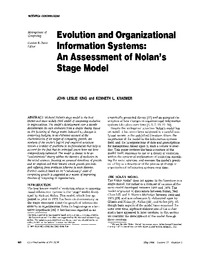 Diese Seite wurde seit 20 Jahren inhaltlich nicht mehr aktualisiert.
Unter Umständen ist sie nicht mehr aktuell.
Diese Seite wurde seit 20 Jahren inhaltlich nicht mehr aktualisiert.
Unter Umständen ist sie nicht mehr aktuell.
 Zusammenfassungen
Zusammenfassungen
Richard Nolan's stage model is the best
known and most widely cited model of computing evolution
in organizations. The model's development over a decade
demonstrates its own evolution from a simple theory, based
on the factoring of change states indicated by changes in
computing budgets, to an elaborate account of the
characteristics of six stages of computing growth. An
analysis of the model's logical and empirical structure
reveals a number of problems in its formulation that help to
account for the fact that its principal tenets have not been
independently validated. The model is shown to be an
"evolutionistic" theory within the theories of evolution in
the social sciences, focusing on assumed directions of growth
and an implied end state toward which growth proceeds,
and suffering from problems inherent in such theories.
Further research based on an "evolutionary" view of
computing growth is suggested as a means of improving
theories of computing in organizations.
empirically grounded theory [27] and an accepted de-
scription of how changes in organizational information
systems take place over time [1, 2, 7, 13, 22, 29].
Despite the widespread attention Nolan's model has
attracted, it has never been subjected to a careful ana-
lytical review in the published literature. Given the
importance of the model in the information systems
field, and the interpretations of data and prescriptions
for management based upon it, such a review is over-
due. This paper reviews the basic structure of the
model itself, discusses its use as a theory of evolution
within the context of explanations of evolution describ-
ing the social sciences, and assesses the model's practi-
cal utility as a descriptor of the process of change in
organizational information systems over time.
Von John Leslie King, Kenneth L. Kraemer  im Text Evolution and Organizational Information Systems (1984)
im Text Evolution and Organizational Information Systems (1984)  Dieser wissenschaftliche Zeitschriftenartikel erwähnt ...
Dieser wissenschaftliche Zeitschriftenartikel erwähnt ...
 Personen KB IB clear | Richard L. Nolan | |||||||||||||||||||||||||||
 Begriffe KB IB clear | Nolan-Stage I: Initiation
, Nolan-Stage II: Contagion
, Nolan-Stage III: Control
, Nolan-Stage IV: Integration
, Nolan-Stage V: Data AdministrationNolan-Stage V: Data Administration
, Nolan-Stage VI: MaturityNolan-Stage VI: Maturity
,  Phasenmodell von Nolan Phasenmodell von Nolan
| |||||||||||||||||||||||||||
 Texte |
|
 Tagcloud
Tagcloud
 Zitationsgraph
Zitationsgraph
 Zitationsgraph (Beta-Test mit vis.js)
Zitationsgraph (Beta-Test mit vis.js)
 1 Erwähnungen
1 Erwähnungen 
- Konzepte und Wirkungszusammenhänge bei Beschaffung und Betrieb von Informatikmitteln an Schulen (Beat Döbeli Honegger) (2005)



 Volltext dieses Dokuments
Volltext dieses Dokuments
 Anderswo suchen
Anderswo suchen 
 Beat und dieser wissenschaftliche Zeitschriftenartikel
Beat und dieser wissenschaftliche Zeitschriftenartikel
Beat war Co-Leiter des ICT-Kompetenzzentrums TOP während er Dieser wissenschaftliche Zeitschriftenartikel ins Biblionetz aufgenommen hat. Zum letzten Mal hat er Dieser wissenschaftliche Zeitschriftenartikel bearbeitet während seiner Zeit am ICT-Kompetenzzentrum TOP. Beat besitzt kein physisches, aber ein digitales Exemplar. (das er aber aus Urheberrechtsgründen nicht einfach weitergeben darf). Es gibt bisher nur wenige Objekte im Biblionetz, die dieses Werk zitieren.











 , 1025 kByte)
, 1025 kByte)  Biblionetz-History
Biblionetz-History